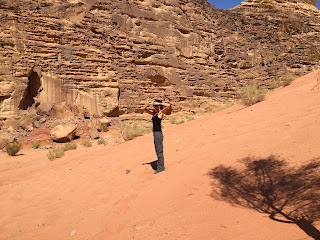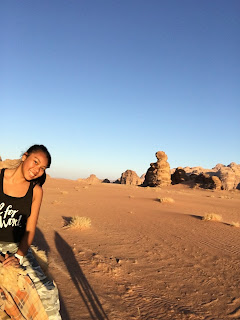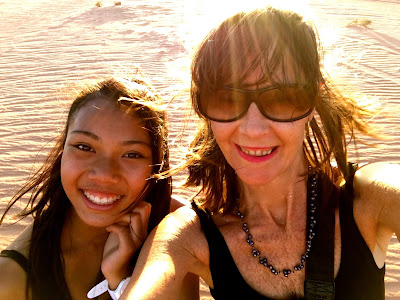 Wadi Rum was another type of desert and only 2 hours from Petra. It's a series of hills and dunes stretching 100km with rocky outcrops which stretches to Saudi Arabia.. It was so different to the flat Australian desert. Apparently most people go to Wadi Rum for a half day trip from Aqaba or Petra but I'm so glad we stayed here 2 days - look at our "hotel room", our tent which didn't have electricity and was steaming hot when we put our bags there at 3pm. They were going to give us a tent with twin beds but Mum asked if we could have one at the front and because there were only 2 other tents being used by tourists (their occupancy was 8%!) we got one right on the edge, even if it meant Mum & I shared a bed it was worth it!.
Wadi Rum was another type of desert and only 2 hours from Petra. It's a series of hills and dunes stretching 100km with rocky outcrops which stretches to Saudi Arabia.. It was so different to the flat Australian desert. Apparently most people go to Wadi Rum for a half day trip from Aqaba or Petra but I'm so glad we stayed here 2 days - look at our "hotel room", our tent which didn't have electricity and was steaming hot when we put our bags there at 3pm. They were going to give us a tent with twin beds but Mum asked if we could have one at the front and because there were only 2 other tents being used by tourists (their occupancy was 8%!) we got one right on the edge, even if it meant Mum & I shared a bed it was worth it!.
We didn't stay in the tent for long, just to dump our bags, because we wanted to start exploring which we did for 3 hours in a 4WD.
There are many springs and wells in Wadi Rum but we didn't see any, perhaps because we were there in summer when the guide books say: "it's extreme in summer and miserably hot with temperatures of 40 degrees". We didn't notice the heat, except in our tent.
There are sculptured rocks, sand dunes and Bedouin tents. It's now a protected area since 1988 which aims to promote tourism for the benefit of the local communities but also to protect the fragile desert ecosystem.
The driver stopped at one sand dune and told us to walk up and to take photos. He said it was what most tourists wanted to do, but Mum & I decided not to walk up because it was nothing compared to the Mui Ne sandunes in Vietnam - where they had cardboard to sand-surf down! We did take photos though!
Mum didn't walk as far as me!
 This is the area Colonial TE Lawrance was based before the Arab Revolt. The Australian Lighthorseman were near here too. In WW1 trench warfare was used and I now understand how difficult it was to dig trenches in shifting loose sand when it kept falling in as soon as it was dug. (They ended up have two groups, one dug and the other had timber covered with course grass and wire which they quickly put inside the hole).
This is the area Colonial TE Lawrance was based before the Arab Revolt. The Australian Lighthorseman were near here too. In WW1 trench warfare was used and I now understand how difficult it was to dig trenches in shifting loose sand when it kept falling in as soon as it was dug. (They ended up have two groups, one dug and the other had timber covered with course grass and wire which they quickly put inside the hole).
The Bedouins have mostly had stewardship for the desert as they roamed here for centuries. There are 5000 today but mostly they live in villages in Rum but as far as they are concerned this doesn't make them any less Bedouin. As we whirred around in our 4WD we stopped every hour at a Bedouin's tent for drinks, it was always tea with sage and cardamon. We were so thirsty (we forgot water again!) that we drank many glasses at each stop. Here's one stop:


The sandstone rocks were like monuments. Medicinal plants are pocketed through the desert which we wouldn't have seen if our driver hadn't stopped to show us. The Bedouins still use them today. It's a complex ecosystem where animals only come out at night. We didn't see poisonous scorpions or snakes or the camel spider which is a fast runner. I googled it before we got here, the person doesn't feel the bite as it numbs the site but afterwards is very painful. We saw prints on the sand outside our tent in the morning! [Colonel Lawrence described the snakes being a serious problem because they killed the camels]. Even though I was hot, I refused to have any part of my skin showing (except my neck and face of couse) in case a camel spider was crawling about. Camel spiders kept me awake all night - literally!
The sand changes colour as the sun migrates across the sky.
The Nabataeans settled in Wadi Rum in the 4th century BC, because this was part of the trading route and the camel caravans. There are inscriptions of the walls of the sandstone cliffs, of camels!


which I photographed.
This is the area Colonel T.E. Lawrence based himself before the Arab Revolt. I watched the original 1962 film Lawrence of Arabia starring Peter O'Toole which was filmed at Wadi Rum.
Lawrence was a British colonel and part of British intelligence in World War 1. He was involved in the Middle East campaign, where the British were trying to stop the Turks from advancing and to take Ottoman territory especially after the Ottoman success in Gallipoli. It's hard to explain without a map. The Arabs were wanting to claim independence from the Ottoman Turks and have an Arab state. (this is another example of how nationalism was one of the forces and causes of WW1 - what I'm doing in History).

Lawrence (photo right) had an empathy for the Arabs, he dressed as an Arab, spoke the language and befriended the Arabs. He accompanied the Arab prince who wanted an Arab state, Emir Faisal (photo left), and earned huge respect for the Arabs. Sherif Hussein was Faisal's father and after the Arab success he made Faisal the King of Iraq and Syria, and his other son King of transjordan.
Lawrence got the British to help the Arabs fight the Ottomans which made sense because for different reasons neither wanted the Ottomans to advance or have power. So the British supplied arms, food, gold and camels to the Arabs (who were mostly Bedouins).
The type of fighting in the Middle East was different to what was used in Gallipoli and France. Instead of armies attacking each other in force, they used guerilla warfare. This meant small groups of men, mostly non-military tribesman, launching surprise attacks on the Turks.
The photo below is the exact area Lawrence based himself before the Arab Revolt. This is exactly what he would have seen.
 Lawrence was respected and liked by the Arabs, because he lived with them and supported their demands for independence. The made this inscription of him in the rock, with 1917 engraved.
Lawrence was respected and liked by the Arabs, because he lived with them and supported their demands for independence. The made this inscription of him in the rock, with 1917 engraved. 
Lawrence was a writer and his book The Seven Pillars of Wisdom was published in 1922. Although there is controversy about the truth of everythign he wrote, such as saying he was the first to take Damascus (Syria) when it was the Australian Lighthorsemen who did, he described the area or Wadi Rum evocatively.
"The crags were capped in nests of domes, less hotly red than the body of the hill; rather grey and shallow. They gave the semblance of Byzantine architecture to this irrestible place: this processional way greater than imagination. Our little caravan grew self-consciou, and fell dead quiet, afraid and ashamed the flaunt its smallness in the presence of the stupendous hills."
Another Bedouin tea stop, and some wandering.


We only had time to throw down a bottle of water after getting back from the 4WD before we headed off on a camel ride to sunset. It was just Mum and me, with Mum's camel having a calf so she accompanied us!
 It seemed right to ride a camel where Lawrence did, with his team which included Arabs, Bedouins, the Australian & British and the Imperial Camel Corp. The ICC was formed in 1916 to fight the Ottoman Turks in the Middle East and the first four ICC companies were from the Australian Infantry battalians after they had recuperated from Gallipoli.
It seemed right to ride a camel where Lawrence did, with his team which included Arabs, Bedouins, the Australian & British and the Imperial Camel Corp. The ICC was formed in 1916 to fight the Ottoman Turks in the Middle East and the first four ICC companies were from the Australian Infantry battalians after they had recuperated from Gallipoli. There's not much to write about here, we rode for about an hour then stopped to watch the sunset and rode back. It was quite breathtaking see the desert change its colours so dramatically during the 3 hours we were out.

Camel wanderings
Mum was taking photos of me from her camel .. sometimes she missed and I had to maneouver myself to get in the frame!
Desert selfie!


























No comments:
Post a Comment